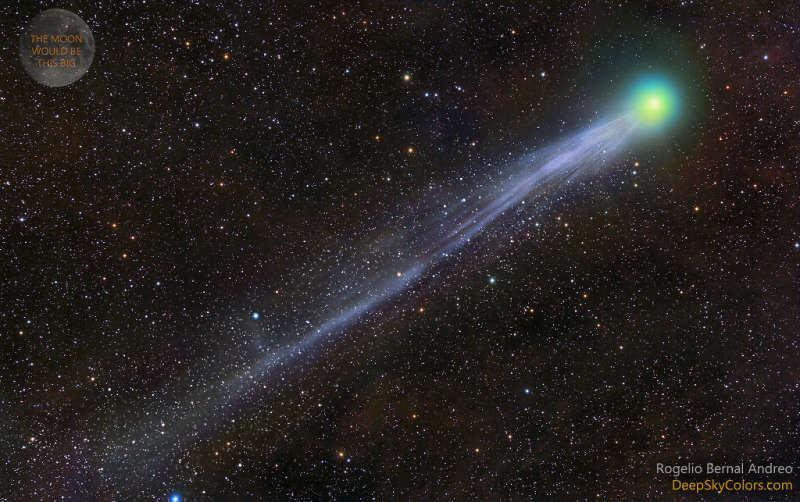Credit & Copyright: Rogelio Bernal
Andreo (Deep Sky Colors)
Explanation:
Sweeping north
in planet Earth's sky, Comet Lovejoy's greenish coma
and blue tinted ion tail stretched across this
field of stars in
the constellation Taurus on January 13.
The inset at the upper left shows the 1/2 degree angular size of
the full moon for scale.
So Lovejoy's coma appears only a little smaller (but much fainter)
than a full moon on the sky, and its tail is visible
for over 4 degrees across the frame.
That corresponds to over 5 million kilometers
at the comet's estimated distance of 75 million kilometers
from Earth.
Blown by the solar wind, the comet's tenuous, structured
ion tail streams
away from the Sun, growing as
this Comet Lovejoy
heads toward perihelion, its closest approach to the Sun, on January 30.
While diatomic carbon
(C2) gas fluorescing in sunlight
produces the coma's green color, the fainter bluish tail is tinted by
emission from ionized carbon monoxide (CO+).
1999 2000 2001 2002 2003 2004 2005 2006 2007 2008 2009 2010 2011 2012 2013 2014 2015 2016 2017 2018 2019 2020 2021 2022 2023 2024 2025 |
Yanvar' Fevral' Mart Aprel' Mai Iyun' Iyul' Avgust Sentyabr' Oktyabr' Noyabr' Dekabr' |
NASA Web Site Statements, Warnings, and Disclaimers
NASA Official: Jay Norris. Specific rights apply.
A service of: LHEA at NASA / GSFC
& Michigan Tech. U.
|
Publikacii s klyuchevymi slovami:
comet - comet tail - komety - kometnye hvosty
Publikacii so slovami: comet - comet tail - komety - kometnye hvosty | |
Sm. takzhe:
Vse publikacii na tu zhe temu >> | |
